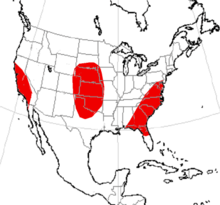| Pediomeryx Temporal range: Late Miocene–Early Pliocene ~10.3–4.9 Ma PreꞒ Ꞓ O S D C P T J K Pg N | |
|---|---|
| Scientific classification | |
| Domain: | Eukaryota |
| Kingdom: | Animalia |
| Phylum: | Chordata |
| Class: | Mammalia |
| Order: | Artiodactyla |
| Family: | †Dromomerycidae |
| Tribe: | †Cranioceratini |
| Genus: | †Pediomeryx Stirton, 1936 |
| Species | |
| |

| |
| Range of Pediomeryx based on fossil distribution | |
Pediomeryx is an extinct genus of artiodactyl, of the family Dromomerycidae, endemic to North America. It lived during the Late Miocene Early Pliocene 10.3—4.9 Ma, existing for approximately 5 million years. Fossils have been recovered from the Midway Site in Florida, the Gray Fossil Site in northeast Tennessee, several sites in Nebraska and Wyoming, Saskatchewan, and Boron, California. They were comparable in size to red deer, with most specimens weighing 100–200 kg but surpassing 400 kg in the case of P. figginsi.
References
- Pediomeryx at fossilworks
- David Lambert, W. (2006). "Functional Convergence of Ecosystems: Evidence from Body Mass Distributions of North American Late Miocene Mammal Faunas". Ecosystems. 9 (9): 97–118. Bibcode:2006Ecosy...9...97L. doi:10.1007/s10021-005-0076-8.
| Taxon identifiers | |
|---|---|
| Pediomeryx | |
 | This prehistoric even-toed ungulate-related article is a stub. You can help Misplaced Pages by expanding it. |